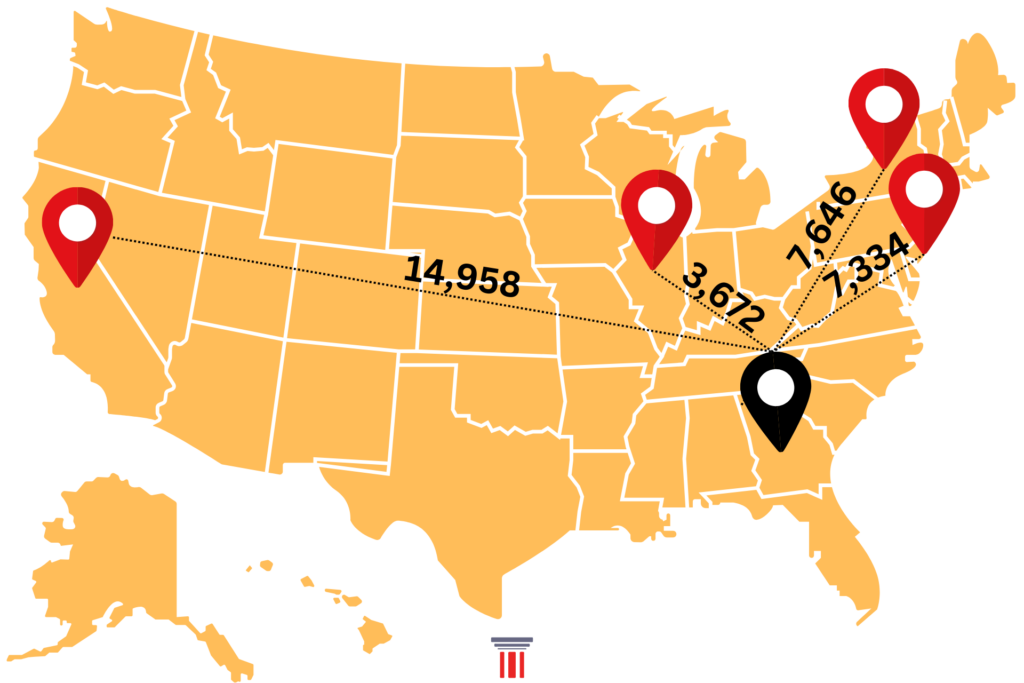
The numbers don’t lie.
In recent years, there has been significant migration from high-tax and high-regulation states to economically free states with lighter tax and regulatory burdens.
This migration pattern paints a compelling picture. States like California, New York, New Jersey and Illinois are losing residents to Florida, Texas — and of course, Georgia, which is renowned for its relatively low taxes and business-friendly environment.
Just three states welcomed more people last year. Specifically, data show that while just 8,889 individuals moved from Georgia to New York, a staggering 16,535 people — nearly double — made the reverse move from New York to Georgia. This resulted in a net migration of 7,646 individuals favoring Georgia over New York. A similar trend is evident in migration flows from New Jersey, Illinois and California, with Georgia consistently attracting more residents from these states than it loses.
Number of residents moving from California, Illinois, New Jersey and New York to Georgia last year, according to the U.S. Census Bureau

The reasons behind this migration pattern are clear: Economically free states offer lower taxes and better environments for businesses and individuals to succeed.
This migration trend toward economic freedom was highlighted in a 2021 report from the American Enterprise Institute, and it continues to hold true.
We keep hearing the same economic reasons for relocating from new Georgia residents moving to our state from across the country, and it’s no wonder: Free market policies promote business activity and overall economic productivity, which consistently foster a healthy economy. This has worked in Georgia, which boasts a burgeoning job market that draws professionals seeking career opportunities in a diverse range of industries.
Larry Edwards, who recently moved from Oregon to Georgia, said he is happy here because of “less government intrusion in my life.” Oregon has a 9.90% top income tax rate, which he was happy to escape.
Many positive data points illustrate that economically free states outperform economically restrictive states.
The Freedom in the 50 States project from the Cato Institute presents a holistic picture of the country, ranking each state in terms of economic freedom. Not surprisingly, some of the states losing the most population are among the least free: New York (50), California (48), New Jersey (46) and Illinois (39). In contrast, states gaining population such as Florida (2), Georgia (5) and Texas (6) are some of the most free.
Several specific data points also illustrate the economic difference of life in these states.
Personal income tax rates are the highest in California (13.3%), Hawaii (11%), New York (10.9%) and New Jersey (10.75%). While Florida and Texas do not have an income tax, Georgia’s is also relatively low (5.49%), with efforts to push it lower. There are wide gaps in property taxes as well. The effective real estate tax rates in New Jersey (2.46%) and Illinois (2.29%) lead the country in this category, while Georgia (0.95%) and Florida (0.89%) are middle of the road, ranked 25th and 28th, respectively.
Small businesses and entrepreneurs consistently face restrictive policies in California, New Jersey and New York. Meanwhile, Georgia, Florida and Texas consistently promote free economic environments for thriving businesses.
The cost of living is another primary driver of migration, which is strongly correlated with economic freedom. Three of the top four states with the highest costs of living are also New York, New Jersey and California. Georgia, Texas and Florida are around the middle. (The lowest cost of living states are mostly in the rural Midwest.)
One argument could be made that people are fleeing cities for rural areas. But a city-to-city comparison also favors Georgia. According to a current cost of living comparison, rent prices in Atlanta are 43.5% lower than in New York City and 27.5% lower than in Los Angeles. This affordability factor becomes a magnet for individuals and families looking to stretch their dollars further. This is especially true in the post-pandemic world where so many can work from wherever they would like.
The larger issue for New York and California shows the populations of those states each declined by about half a million. As much as the leaders of those states might tell us that everyone loves their policies and way of life, the data tell us something different. To illustrate this further, in 2022, Florida, Texas, North Carolina and Georgia made up 93% of U.S. population growth.
Thankfully, these trends illustrate a type of scorecard for the effectiveness of public policy in Georgia. They show us that we are doing something right, even if the people moving here don’t realize it. No one moves to a state because of some ranking, but because of opportunity.
Because of sound policy, Georgia, and similar states, can offer that opportunity so many are looking for.